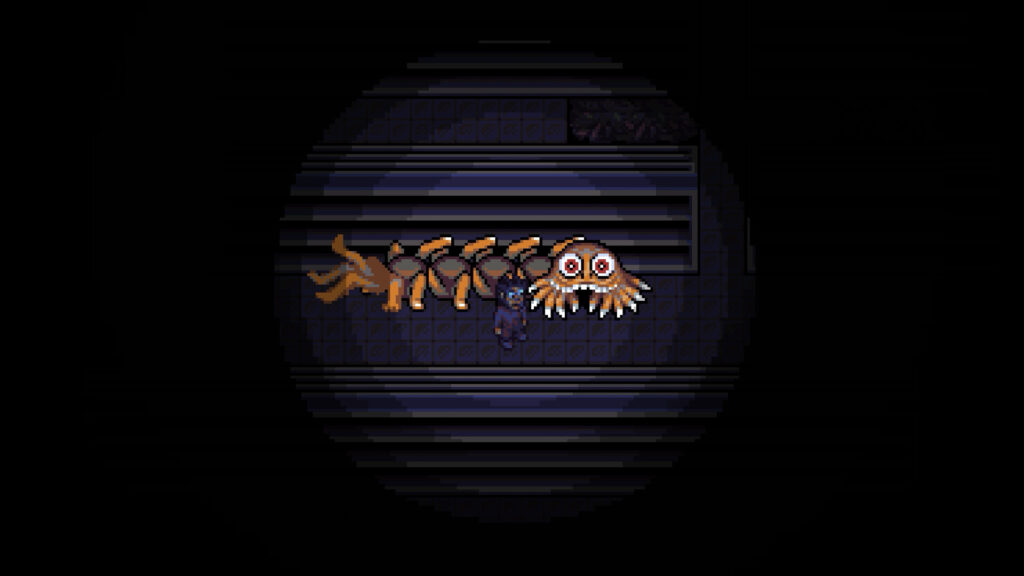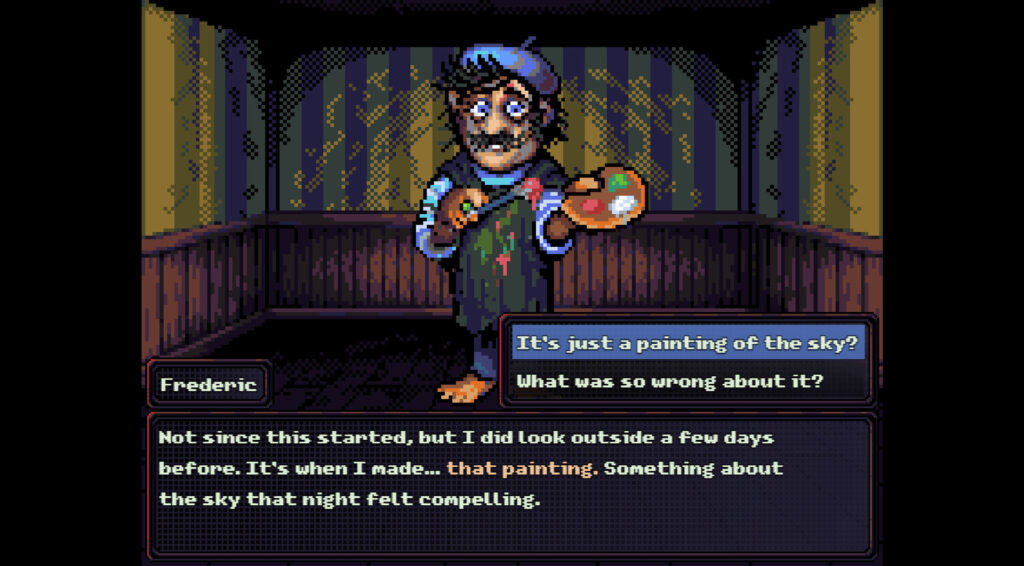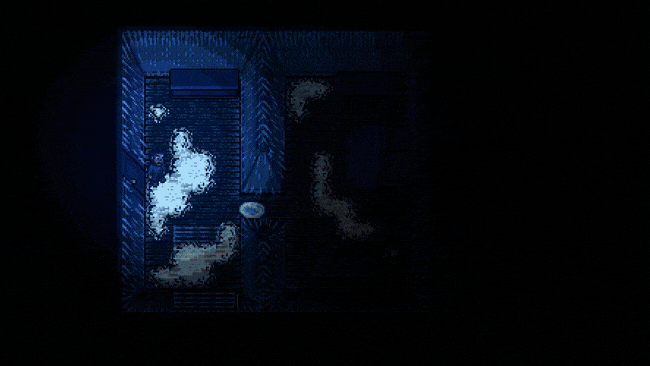Look Outside isn’t your typical survival horror RPG — it’s a psychological nightmare wrapped in cosmic terror and body horror. Developed by an indie team with a knack for unsettling experiences, this game throws you into the confines of a dimly lit apartment building where reality is unraveling. Looking outside is deadly, but the temptation to uncover the truth is irresistible.
You’re tasked with surviving for 15 days in a world where even a glimpse of the outside turns people into grotesque creatures. With its turn-based combat, resource management, NPC interactions, and branching narrative, Look Outside doesn’t just challenge your reflexes — it messes with your mind. Every choice matters, and every mistake has severe consequences.
Here’s a deep dive into what makes Look Outside an unforgettable (and often unforgiving) horror experience.
A Cosmic Catastrophe: What’s Going On?
You wake up in your small apartment to the eerie sound of a voice urging you to look out the window. But don’t — or it’s game over. The world outside has been twisted by an unknown cosmic phenomenon, transforming those who dare to look into nightmarish entities.
Your apartment building is now a prison where survival depends on making the right choices, trusting the right people, and managing dwindling resources. But what’s happening outside? Is it a government experiment gone wrong? An alien invasion? Or something far more sinister?
As the days go by, NPCs like Sybil, Lyle, and Vincent provide cryptic clues, each conversation adding layers to the narrative. But beware — trusting the wrong person can lead to unexpected and horrifying consequences.

Survive 15 Days: Core Gameplay and Mechanics
Exploration with Consequences
Time only advances when you enter new areas, giving you a chance to explore thoroughly. However, staying out too long raises the danger level, attracting more dangerous creatures. The world grows deadlier with every passing hour, making exploration a high-risk, high-reward gamble.
Turn-Based Combat with Unpredictable Mutations
Combat in Look Outside is tense and strategic. Enemies aren’t just grotesque — they mutate mid-battle, altering their attacks and status effects. Your weapons degrade quickly, and status effects can cripple your character if left unchecked. Balancing offensive tactics with defensive preparation is key to survival.
NPC Interactions and Dialogue Choices
Your neighbors offer more than just cryptic clues — they can be allies, enemies, or something in between. Dialogue choices influence how events unfold, with some interactions leading to new quests and others straight to disaster. NPCs like Lyle, with his unsettling photography obsession, and Sybil, who seems to know more than she lets on, add depth to the narrative.
Crafting and Resource Management
Scraps, chemicals, and random objects scattered around the building can be crafted into weapons, healing items, and Molotovs. But resources are scarce, and deciding when to craft or conserve can mean the difference between life and death.
Saving and Danger Levels: A Risky Mechanic
You can only save your progress after raising your danger level to a certain point and returning home. This system adds tension and forces you to weigh the risks of exploring too far. Death means losing all progress since your last save — and in Look Outside, death is always one bad decision away.

Narrative Depth and Cosmic Horror
The Mystery of the Outside Phenomenon
The heart of Look Outside is its mysterious cosmic event that has warped reality. What caused it? Why does simply looking at it twist people into grotesque forms? The deeper you explore, the more horrifying the answers become — but understanding the truth might drive you mad.
Body Horror and Grotesque Mutations
The game leans heavily into body horror, with NPCs and enemies alike exhibiting disturbing mutations. One memorable moment involves an eyeball monster growing inside a neighbor’s chest, transforming a seemingly innocent act of kindness into a nightmarish fight for survival.
NPCs with Hidden Agendas
Characters like Lyle and Sybil add a layer of unpredictability. Lyle’s obsession with photography hints that taking pictures may somehow be tied to the cosmic phenomenon. Sybil, on the other hand, offers cryptic advice that can either save or doom you. Each NPC interaction feels layered, and trusting the wrong person can lead to deadly consequences.
Visuals and Sound: Oppressive and Claustrophobic
Pixel Art with an Unsettling Twist
Look Outside uses pixel art graphics to evoke a sense of claustrophobic dread. The grimy apartment hallways, blood-streaked walls, and grotesque NPC designs all contribute to the oppressive atmosphere. Despite the pixelated aesthetic, the level of detail in the character designs — especially the mutated enemies — is genuinely unsettling.
Sound Design That Keeps You on Edge
The game’s sound design deserves special praise. Eerie background noises, distorted whispers, and sudden audio cues build tension, making every moment feel fraught with danger. When enemies appear, the music ramps up, creating a chaotic, nerve-racking atmosphere that perfectly complements the action.
Memorable Moments: WTF Just Happened?
Vincent’s Grotesque Transformation: Your once-normal neighbor Vincent turns into a multi-eyed monstrosity that bleeds profusely and attacks relentlessly.
The First Death by Curiosity: You’ll probably look outside once — just to see what happens. Spoiler: It’s bad.
Eyeball Monster in Your Neighbor’s Chest: Helping a wounded neighbor quickly turns into a grotesque nightmare.
Lyle’s Creepy Photography Obsession: Agreeing to let Lyle take your picture has unexpected (and horrifying) consequences.
The Grinning Beast Chase: Staying out too late triggers a chase sequence where survival feels almost impossible.

🎯 Why Look Outside Will Haunt Your Dreams
✅ What Makes Look Outside Stand Out
1. Psychological Tension and Unique Premise
The idea that looking outside can instantly end the game adds an oppressive sense of dread. Every time you get close to a window or reflective surface, the temptation to see what’s beyond adds to the tension. This constant threat lingers in the background, making even mundane tasks feel nerve-wracking.
2. Deeply Layered Narrative with Cryptic NPCs
Interactions with NPCs like Lyle and Sybil add multiple layers to the game’s narrative. Their cryptic advice and unsettling behavior hint at a much larger cosmic mystery unfolding outside. Each conversation feels like peeling back a layer of the unknown, drawing you deeper into the madness.
3. Brutal and Strategic Turn-Based Combat
The combat system in Look Outside isn’t your typical hack-and-slash. Enemies mutate mid-battle, adding an unpredictable layer of challenge. Pair that with degrading weapons and status effects, and you’ve got a combat system that demands careful planning, making every encounter feel like a life-or-death decision.
4. Exploration That Rewards (and Punishes) Curiosity
Exploration is rewarding but perilous. Time only moves forward when you enter new areas, encouraging thorough investigation. However, staying out too long raises the danger level, increasing the likelihood of encountering deadly entities. The balance between curiosity and survival makes every decision feel impactful.
5. Oppressive Atmosphere and Pixel Art Horror
The pixel art aesthetic gives the game a retro charm while simultaneously evoking an overwhelming sense of dread. Dim hallways, blood-streaked floors, and grotesque creature designs make every environment feel suffocating. The unnerving sound design — filled with distorted whispers and eerie background noises — adds to the overall tension.
❗️ Why Look Outside Might Drive You Insane
⚠️ Challenges That Could Frustrate Players
1. Lack of Clear Guidance and Objective Clarity
Look Outside drops you into a chaotic world with minimal explanation. Figuring out what to do and where to go often relies on trial and error, which can frustrate players who prefer a more guided experience. Expect to feel lost during your first few runs.
2. Punishing Difficulty and Harsh Save System
The game’s save system is tied to danger levels, meaning you can only save after specific conditions are met. This adds tension but also means that one wrong decision can erase hours of progress. If you’re not prepared for permadeath, expect to restart multiple times.
3. Clunky UI and Inventory Management
Inventory management and crafting feel cumbersome at times. Switching weapons and accessing healing items can feel unintuitive, especially during high-stakes encounters. Crafting, while essential, can also slow down the gameplay, adding a layer of frustration.
4. Harsh Weapon Durability System
Weapons degrade quickly, often breaking mid-battle. This mechanic forces you to craft replacements, but resources aren’t always easy to come by, leaving you vulnerable at critical moments. If you’re not careful, running out of weapons mid-fight can be a death sentence.
5. High Learning Curve with Little Mercy
Look Outside doesn’t hold your hand — and that’s part of its charm. However, for players new to survival horror or those unfamiliar with roguelike elements, the lack of mercy can be overwhelming. It’s a steep learning curve where every mistake is costly.
🎮 Survival Tips to Keep You Alive
✅ Don’t Look Outside: Seriously, it’s not worth the curiosity. You’ll regret it.
✅ Save Smart: Return home to save after any major discovery. Don’t wait too long.
✅ Conserve Resources: Weapons and items degrade quickly, so use them strategically.
✅ Explore Thoroughly: Time moves only when you enter new areas — take advantage of this.
✅ Trust Carefully: NPCs may seem helpful, but not everyone is on your side. Choose your allies wisely.
A Cosmic Horror That’s Unforgiving but Unforgettable: Look Outside is a deeply unsettling horror RPG that mixes exploration, cosmic dread, and unforgiving combat into one unforgettable package. While the punishing difficulty and lack of guidance may frustrate some, the rewards for perseverance make it a must-play for horror enthusiasts. If you’re looking for a game that challenges not just your reflexes but also your sanity, Look Outside delivers an unforgettable journey into the unknown. – Obsidian


